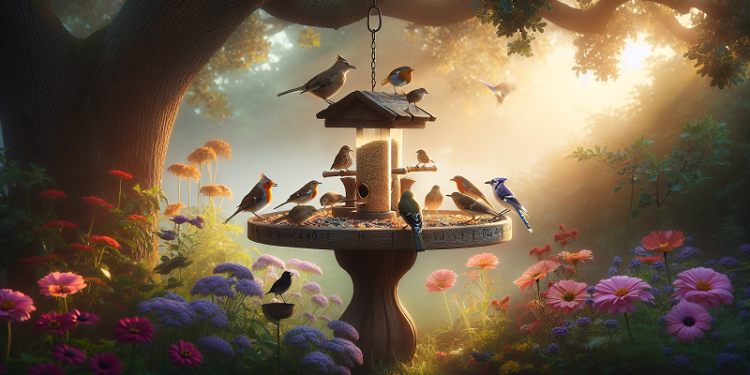Introduction
Bringing nature and art together in your outdoor space can create a beautiful and inviting environment for both you and your feathered friends. One way to achieve this is by crafting a stunning bird table that not only provides a place for birds to feed but also adds a unique and decorative element to your garden or backyard.
The Importance of Bird Tables
Bird tables play a crucial role in supporting local bird populations by providing them with a reliable food source, especially during the colder months when natural food is scarce. By offering a variety of food options, such as seeds, nuts, and fruits, you can attract a diverse range of bird species to your outdoor space.
Choosing the Right Location
When selecting a location for your bird table, consider factors such as visibility, accessibility, and safety. Place the table in an area where you can easily observe the birds from a distance without disturbing them. Ensure that the table is positioned away from potential predators, such as cats or hawks, and near natural shelter like trees or shrubs.
Designing Your Bird Table
Functionality Meets Aesthetics
A well-designed bird table should combine functionality with aesthetics. Consider the size and shape of the table, as well as the materials you will use. A sturdy, weather-resistant wood like cedar or teak is ideal for outdoor use. Incorporate features such as drainage holes to prevent water from accumulating and a sloped roof to protect the food from rain and snow.
Incorporating Artistic Elements
To elevate your bird table from a simple feeder to a work of art, consider adding decorative elements such as intricate carvings, colorful paint, or mosaic tiles. Draw inspiration from nature, such as leaves, flowers, or even the birds themselves, to create a unique and eye-catching design.
Choosing the Right Food
Seed Mixes
Offer a variety of seed mixes to attract different bird species. Black oil sunflower seeds are a popular choice among many birds, while nyjer seeds are favored by finches. Millet, cracked corn, and safflower seeds are also attractive options.
Nuts and Fruits
In addition to seeds, offer nuts and fruits to provide a balanced diet for your feathered visitors. Unsalted peanuts, almonds, and walnuts are excellent choices. Fresh or dried fruits, such as apple slices, raisins, and berries, can also be appealing to birds.
Avoid Harmful Foods
Refrain from offering birds food that can be harmful to their health, such as bread, chocolate, or avocado. These foods can cause digestive issues or even be toxic to certain bird species.
Maintaining Your Bird Table
Regular Cleaning
To ensure the health and safety of the birds visiting your table, regular cleaning is essential. Remove any uneaten or spoiled food daily and give the table a thorough cleaning with a mild, bird-safe disinfectant solution every few weeks.
Monitoring for Pests
Keep an eye out for any signs of pests, such as mold, mildew, or insects, which can contaminate the food and pose a risk to the birds’ health. Address any issues promptly to maintain a safe feeding environment.
Attracting a Variety of Bird Species
Providing Multiple Feeding Stations
To accommodate different bird species and their feeding preferences, consider offering multiple feeding stations. In addition to your main bird table, hang feeders with various seed mixes or provide a birdbath for drinking and bathing.
Creating a Bird-Friendly Habitat
Enhance your outdoor space by creating a bird-friendly habitat. Plant native trees, shrubs, and flowers that provide natural food sources, nesting sites, and shelter. Add birdhouses or nesting platforms to encourage birds to make your garden their home.
The Benefits of Bird Watching
Connecting with Nature
Observing birds at your bird table allows you to connect with nature and appreciate the beauty and diversity of the avian world. Take time to identify the different species visiting your table and learn about their unique characteristics and behaviors.
Reducing Stress and Promoting Well-being
Engaging in bird watching can have positive effects on your mental health and well-being. The peaceful activity of observing birds can reduce stress, promote relaxation, and provide a sense of tranquility in your outdoor space.
Encouraging Children’s Interest in Nature
Educational Opportunities
A bird table can serve as an excellent educational tool for children, fostering their interest in nature and wildlife. Encourage children to help in the creation and maintenance of the bird table, teaching them about the importance of providing for local bird populations.
Engaging in Citizen Science Projects
Participate in citizen science projects, such as the Great Backyard Bird Count or Project FeederWatch, which involve observing and recording the birds visiting your bird table. This can help children develop a deeper understanding and appreciation for the natural world while contributing to scientific research.
Seasonal Considerations
Adapting to Changing Weather
As the seasons change, adapt your bird table to ensure it remains functional and attractive to birds. During the colder months, provide high-energy foods like suet or peanut butter to help birds maintain their body heat. In the summer, offer fresh water and shade to help birds stay cool.
Celebrating Seasonal Themes
Incorporate seasonal themes into your bird table design to create a dynamic and ever-changing outdoor display. Decorate your table with autumn leaves, winter berries, spring flowers, or summer fruits to reflect the changing seasons and add a touch of whimsy to your outdoor space.
Conclusion
Creating a stunning bird table that combines nature and art is a rewarding endeavor that benefits both you and the birds visiting your outdoor space. By providing a reliable food source, incorporating artistic elements, and maintaining a clean and safe feeding environment, you can enjoy the beauty and tranquility of bird watching while supporting your local avian population. Encourage others to join in the joy of creating bird-friendly habitats and foster a deeper appreciation for the natural world around us.











































































